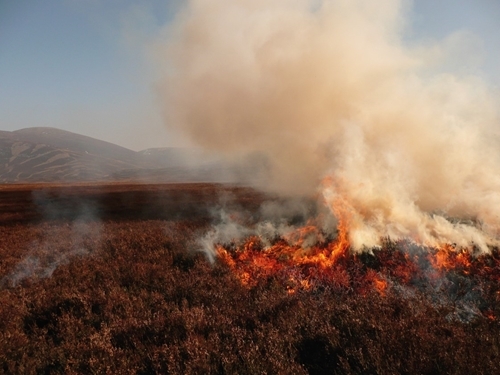
Managed burning can be a valuable tool in restoring peatland vegetation, according to a study undertaken by the Game & Wildlife Conservation Trust (GWCT). Plants such as Sphagnum moss, which makes peat bogs more resilient to drought, was five times higher on areas burnt eight to ten years earlier when compared with unburnt areas, according to the study published in Ecological Indicators. These findings also inform the debate over climate change, with previous research showing that methane emissions are lower from Sphagnum-dominated peatlands than from other types of peatland’.
Dr Sian Whitehead, one of the co-authors of the research, is encouraged by the findings. “These results are further evidence to suggest prescribed ‘cool’ burning at appropriate time intervals can help those plants are particularly well adapted to peat-forming conditions by reducing competition from heather”, she notes. “There should now be more long-term experiments that have properly designed control and burn treatments, as well as considering heather mowing, to better understand the impact on vegetation and peatland function”.
Scientists at the GWCT revisited randomly selected plots at Langholm Moor, which had been managed with prescribed ‘cool’ burns‘ between four and ten years previously. They measured the percentage cover of heather, cotton grass, Sphagnum, and other mosses and compared it with findings at 16 unburnt control plots. They also recorded vegetation height, moss depth and vegetation biomass, with all of these measurements then being considered in relation to burn-age.
Cool burns are those that are conducted during the winter or early spring, when relatively cool, damp conditions allow a rapid fire to be managed through the canopy vegetation, but with minimal heat damage at ground level.
This new research helps to inform a continuing debate into upland management, with some conservation bodies and pressure groups arguing to ‘ban the burn’.
Last November, MPs discussed the matter of moorland burning in a Westminster Hall debate. During the debate Labour MP for Sheffield Hallam, Olivia Blake, claimed that ‘burning harms the sphagnum mosses.’ While high temperatures during burns can damage Sphagnum, it can recover from low intensity (cool) burns within the same growing season. Therefore, cool burns can reduce heather cover without destroying the Sphagnum layer beneath.
With the UK witnessing over 110 wildfires in 2020, the role of managed burning is keenly debated. Prescribed management fires can reduce the amount fuel available, therefore reducing both the intensity and severity of any fire that does occur. Removing the excess vegetation can provide fire breaks, disrupting fire fronts. Gamekeepers on grouse moors have considerable experience and adequate equipment to tackle wildfires but this could all be lost if they are no longer able to conduct prescribed burns.
It is important that those deciding future policy understand the complexity of the issue. During the same debate, it was claimed that 68% of wildfires in the higher uplands have been caused by so-called controlled cold fires. This has been shown to be untrue. Almost all upland fires (90%) had no recorded cause of ignition and were therefore not included in the cited figures. The correct context for this figure is that 68% of the 10% of upland wildfires that have a known cause were from controlled burning. There needs to be more recorded information on the causes of wildfires to gain a full picture on what the risks are.